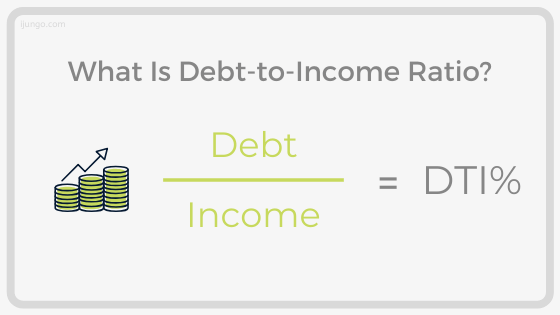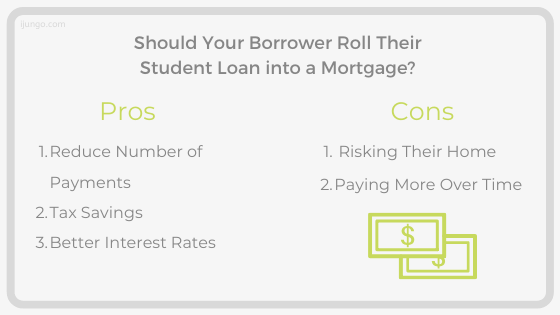

In the past 10 years, outstanding student loan balances have more than doubled. On average, Americans have $37,113 in student loan debt, which is over a 26% increase from the past five years.
The Federal Reserve estimates that the 20% decline in homeownership among young people is due to rising student loan debt.
And since 14.4% of consumers carry student loans, this is a widespread issue.
Mortgages with High Student Loan Debt
The recently released 2019 Zillow Group Report on Consumer Housing Trends says, “More than two-thirds of renters have debt, and about a quarter of renters and homebuyers said that their debt caused them to be denied either a rental agreement or mortgage at some point.”
It goes on to say, “32% of Gen Z and millennial buyers said their debt caused them to be turned down for home financing, compared to 25% of Gen X and 8% of Boomer and Silent Generation buyers.”
Clearly, getting a mortgage with high student loan debt is difficult for borrowers. So, how can loan officers support their borrowers, who face the special challenges involved in rising student loan debt?
There are a few things you can do:
- Discuss How Debt Affects Earning a Mortgage
- Offer Education and Support
- Refer to Professional Partners
- Consider Rolling Student Debt into a Mortgage
Discuss How Debt Affects Getting a Mortgage
When a lender is considering a borrower’s ability to qualify for a mortgage, there are many factors they will examine. In addition to credit score, another important element is a borrower’s debt-to-income (DTI) ratio. DTI is calculated by taking your monthly debt payments, divided by your gross monthly income.

For instance, if a borrower pays $1,800 a month for their mortgage, $200 for their car payment, and $200 for other debts, their monthly debts are $2,200. And if their gross monthly income is $5,800, then their debt-to-income ratio is 38%.
The reason that lenders care about a borrower’s DTI is because a higher DTI indicates that they may have more problems keeping up with their monthly payments. On average, 43% is the highest DTI that a borrower can carry and still qualify for a mortgage.
What Does This Mean For Borrowers with Student Loan Debt?
For your customers who have a high DTI, not all hope is lost. Depending on their credit score, down payment, and savings, some lenders may still qualify them. However, having a low DTI is one of the best ways to ensure that they will be qualified.
Either way, there are ways that a loan officer can help a borrower who is interested in getting a mortgage with high student loan debt.
Offer Education and Support
Like any borrowers, young home buyers may have a lot of questions. After all, the mortgage process is a confusing one. If your borrower is a first time home buyer, or nervous about getting a mortgage with high student loan debt, you have the opportunity to support them.
There are certain questions they might have, such as:
- How much can I afford to spend?
- How much should my down payment be?
- What will my interest rate be?
- How does my credit score affect my mortgage?
- Will it be difficult for me to get a mortgage with high student loan debt?
- How much will property taxes cost?
- How much will I pay in home insurance?
- Will I need to pay for private mortgage insurance?
- What is PMI?
- How long does it normally take for a loan to close?
- What other expenses are involved in buying a home?
If you can answer all of these questions, then you’ll be equipped with the foundational knowledge you need to help answer your borrower’s questions. Especially if they’re new home buyers who carry a lot of debt, being a trusted advisor will help you gain their trust and earn their referrals and potential future business.
Education Through Email
Another way to help support borrowers in their home buying process is to send them educational emails. You can create a series of helpful messages with tips and tricks during the loan and home buying process, and send them to your customers.
CRM Tip
If you don’t have the time or resources to create a campaign such as this on your own, use a pre-built marketing platform that does. Jungo’s marketing campaigns are pre-written and completely customizable. You can place your customers on a drip marketing email campaign that will automatically send them an informative email (from you!) every week. Marketing in this way will not only inform your borrowers about the process of getting a mortgage with high student loan debt, it will also keep you top of mind during the entire process.
Refer Borrowers to Professional Partners
Another way that you can help customers who have student loan debt or other unique challenges facing them, is to refer them to professional partners. For instance, for some borrowers, meeting with a financial advisor may be beneficial to them.
A financial advisor helps you understand your finances and better plan for the future. Most would agree that a part of this long term financial plan is paying off debt.
If you don’t already have a trusted financial advisor you can recommend to your clients, begin to look for one. Ask other loan officers for recommendations, as well as real estate agents and others in surrounding industries. When you refer your customers to a professional partner such as a financial planner, you’re not only helping your client plan for their future, but you’re also building trust. So, when your client is ready for a mortgage, they’ll remember you as the go to resource. Additionally, you’ll be building a valuable relationship with a potential referral partner. Remember, real estate agents aren’t your only source for referrals.
Consider Rolling Student Loan Debt into a Mortgage
Although some consider this a controversial option, borrowers could consider rolling student loan debt into a mortgage. This can ease the burden of student loan debt for your borrowers. Also called debt reshuffling, rolling student loan debt into a mortgage normally means paying off student loans via a cash-out refinance.
There are pros and cons to this option, which we’ll discuss more below. However, it’s important to first address why someone may choose to roll their student loan debt into their mortgage. First, as mentioned above, US consumer student loan debt is growing, which can create a substantial financial burden. Reshuffling debt can be an appealing way to help ease that burden.

The Pros of Rolling Student Loan Debt into a Mortgage
Reduce Number of Payments
By reshuffling debt, borrowers can reduce the number of bills they pay each month. Simply paying one mortgage payment may feel less daunting than multiple payment dates and writing many different checks.
Tax Savings
Although some student loan interest is tax deductible, they can be limited because of a borrower’s income. For instance, if one makes over $80,000 a year, they may not qualify. Mortgages however, do not involve such limitations. Therefore, if your borrower earns a substantial amount per year and pay taxes in a higher tax bracket, they might benefit greatly from rolling their student loans into a mortgage payment.
Better Interest Rates
Improving interest rates is the main reason most borrowers consider consolidating their student loan debt. After all, according to Fannie Mae’s Lawless, most student borrowers pay between 4 and 8 percent interest on their loans. However, the current 30-year mortgage interest rate hovers much closer to 4 percent. Because of this, for some borrowers, it may be financially beneficial to roll all their debt into a loan with a lower interest rate.
The Cons of Rolling Student Loan Debt into a Mortgage
Risking Your Home
If a borrower is unable to pay their student loan bills, their lender can’t take their home or other assets. Their wages may be garnished, but otherwise, student loans are unsecured.
This is not the case when it comes to a mortgage! If a borrower fails to make mortgage payments, their home can be foreclosed upon. By rolling student loan debt into a mortgage, a borrower’s home can be put at risk if they can’t keep up with the payments.
Paying More Over Time
Although a mortgage may have lower interest rates than student loans, it’s important to look at the terms carefully. For instance, a client’s student loans may only have 8 years left to pay, and when you consolidate them into a mortgage, payment may now be extended to 15 or even 30 years. Therefore, help the borrower understand how much they will pay over the life of the loan and if paying more over time is worth it (despite the lower interest rate).
Should Your Borrower Consider Reshuffling Their Debt?
Rolling student loan debt into a mortgage is a controversial way to ease the burden of student loans. However, for some borrowers, with careful consideration for the long term effects, it can be a helpful decision. It’s important to discuss the benefits and risks involved in rolling student loan debt into a mortgage with your customers. Make yourself a trusted advisor by providing educational and helpful advice and insights.
Bottom Line
For today’s mortgage customers, rising student loan debt is becoming even more of a burden. By being willing and available to discuss their loan options, offer advice, and refer them to trusted professional partners, you’ll provide the best customer service you possibly can. Just remember, every borrower is facing unique circumstances, so it’s part of your job as a top producing loan officer to help address their specific needs.






